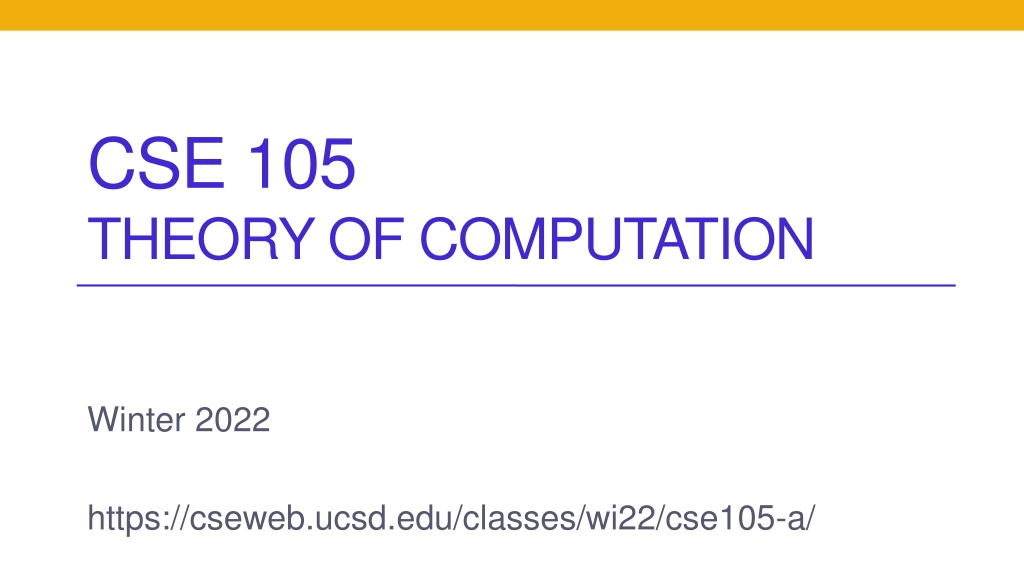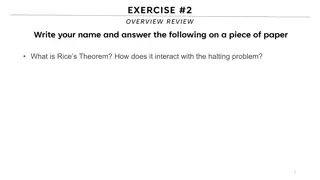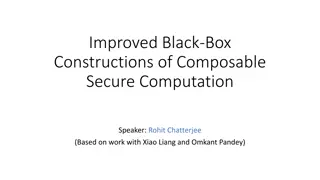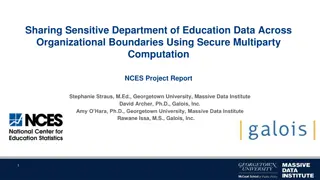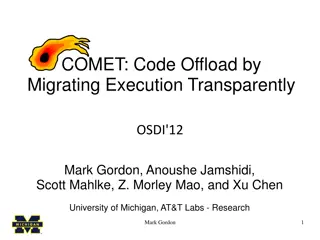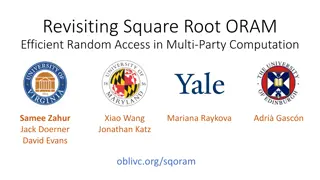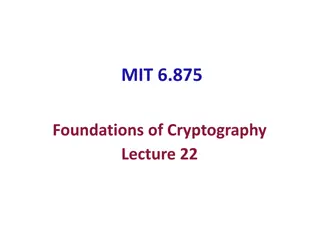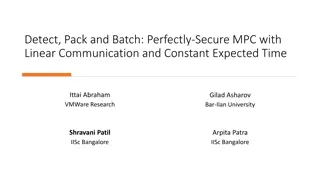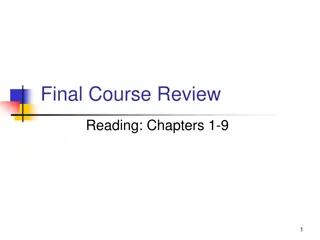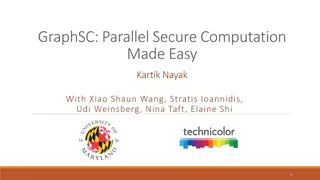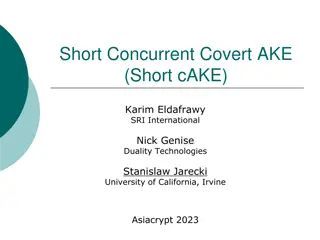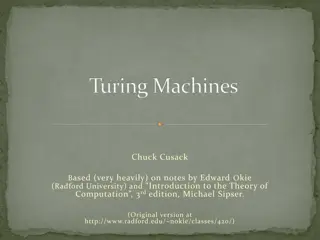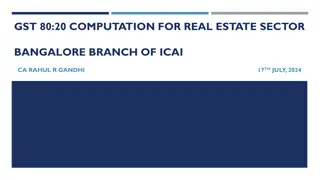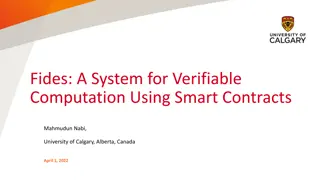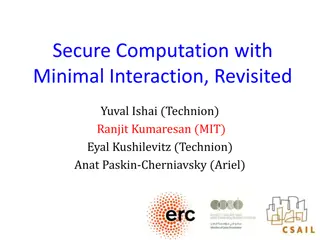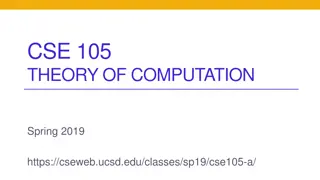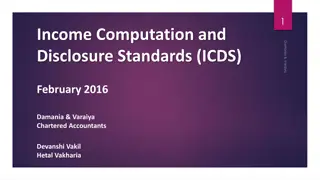Theory of Computation Winter 2022: Learning Goals and Key Concepts
Explore the key concepts in the Theory of Computation for Winter 2022, including decision problems, reductions, undecidability, and the relationship between HALTTM and ATM. Learn about decidable, recognizable, and undecidable problems as well as the importance of reductions in proving undecidability. Dive into Sipser's ideas and the halting problem to enhance your understanding of computational theory.
Download Presentation

Please find below an Image/Link to download the presentation.
The content on the website is provided AS IS for your information and personal use only. It may not be sold, licensed, or shared on other websites without obtaining consent from the author. Download presentation by click this link. If you encounter any issues during the download, it is possible that the publisher has removed the file from their server.
E N D
Presentation Transcript
CSE 105 THEORY OF COMPUTATION Winter 2022 https://cseweb.ucsd.edu/classes/wi22/cse105-a/
Today's learning goals Sipser Ch 5.1 Define and explain core examples of decision problems: ADFA, EDFA, EQDFA, ATM, HALTTM Define reductions from one problem to another. Use reductions to prove undecidability.
So far Decidable Recognizable (and not decidable) ATM Co-recognizable (and not decidable) ATMC ADFA EDFA EQDFA INFINITEDFA RevDFA STM RecTM Give algorithm! Diagonalization
Idea Sipser p. 216 If problem X is no harder than problem Y and if Y is easy then X must also be easy
Idea Sipser p. 216 If problem X is no harder than problem Y and if X is hard then Y must also be hard
Idea Sipser p. 216 If problem X is no harder than problem Y and if Y is decidable then X must also be decidable If problem X is no harder than problem Y and if X is undecidable then Y must also be undecidable
Idea If problem X is no harder than problem Y and if Y is decidable then X must also be decidable Sipser p. 216 If problem X is no harder than problem Y and if X is undecidable then Y must also be undecidable "Problem X is no harder than problem Y" means "Given an algorithm deciding problem Y, we could solve problem X".
The halting problem! HALTTM= { <M,w> | M is a TM and M halts on input w} ATM = { <M,w> | M is a TM and w is in L(M)} How is HALTTM related to ATM ? A. They're the same set. B. HALTTM is a subset of ATM C. ATM is a subset of HALTTM D. They have the same type of elements but no other relation. E. I don't know.
The halting problem! HALTTM= { <M,w> | M is a TM and M halts on input w} ATM = { <M,w> | M is a TM and w is in L(M)} Which of these sets is harder? A. HALTTM B. ATM C. They're both decidable D. They're both undecidable. E. I don't know.
Claim: HALTTM is undecidable. Proof by contradiction
Claim: HALTTM is undecidable. Proof by contradiction Assume we have a machine G that decides HALTTM Build an algorithm that uses G as a subroutine that decides ATM This is impossible! So G cannot possible exist, hence HALTTM is undecidable. Note: Sipser uses R for the machine G. (p. 216)
Claim: HALTTM is undecidable. Let G be the TM that is assumed to decide HALTTM Construct a new TM MATM by: "On input <M,w> 1. Run G on input <M,w>. 2. If G rejects, then reject; else, run M on w. a. If this computation accepts, accept. b. If this computation rejects, reject."
Claim: HALTTM is undecidable. Let G be the TM that is assumed to decide HALTTM Construct a new TM MATM by: "On input <M,w> 1. Run G on input <M,w>. 2. If G rejects, then reject; else, run M on w. a. If this computation accepts, accept. b. If this computation rejects, reject." Which of the machines are deciders? A. All of them: G, MATM, M B. Definitely G and MATM; M may or may not be. C. Definitely G; MATM and M may or may not be. D. None of them has to be. E. I don't know.
Claim: HALTTM is undecidable. Let G be the TM that is assumed to decide HALTTM Construct a new TM MATM by: "On input <M,w> 1. Run G on input <M,w>. 2. If G rejects, then reject; else, run M on w. a. If this computation accepts, accept. b. If this computation rejects, reject." Lemma: MATM decides ATM. Proof of correctness of construction .
Well, the truth is that P cannot possibly be, because if you wrote it and gave it to me, I could use it to set up a logical bind that would shatter your reason and scramble your mind. Here s the trick that I ll use and it s simple to do. I ll define a procedure, which I will call Q, that will use P s predictions of halting success to stir up a terrible logical mess. yet P is supposed to speak truly of it! And if Q s going to quit, then P should say Good. Which makes Q start to loop! (P denied that it would.) No matter how P might perform, Q will scoop it: Q uses P s output to make P look stupid. Whatever P says, it cannot predict Q: P is right when it s wrong, and is false when it s true! I ve created a paradox, neat as can be and simply by using your putative P. When you posited P you stepped into a snare; Your assumption has led you right into my lair. So where can this argument possibly go? I don t have to tell you; I m sure you must know. A reductio: There cannot possibly be a procedure that acts like the mythical P. You can never find general mechanical means for predicting the acts of computing machines; it s something that cannot be done. So we users must find our own bugs. Our computers are losers! SCOOPING THE LOOP SNOOPER A proof that the Halting Problem is undecidable Geoffrey K. Pullum (http://www.lel.ed.ac.uk/~gpullum/loopsnoop.html) No general procedure for bug checks will do. Now, I won t just assert that, I ll prove it to you. I will prove that although you might work till you drop, you cannot tell if computation will stop. For imagine we have a procedure called P that for specified input permits you to see whether specified source code, with all of its faults, defines a routine that eventually halts. You feed in your program, with suitable data, and P gets to work, and a little while later (in finite compute time) correctly infers whether infinite looping behavior occurs. If there will be no looping, then P prints out Good. That means work on this input will halt, as it should. But if it detects an unstoppable loop, then P reports Bad! which means you re in the soup. For a specified program, say A, one supplies, the first step of this program called Q I devise is to find out from P what s the right thing to say of the looping behavior of A run on A. If P s answer is Bad! , Q will suddenly stop. But otherwise, Q will go back to the top, and start off again, looping endlessly back, till the universe dies and turns frozen and black. And this program called Q wouldn t stay on the shelf; I would ask it to forecast its run on itself. When it reads its own source code, just what will it do? What s the looping behavior of Q run on Q? If P warns of infinite loops, Q will quit;
Reduction "Problem X reduces to problem Y"means "Problem X is no harder than problem Y" means "Given an algorithm deciding problem Y, we could solve problem X" means "Given a solution for Y, we have a solution for X" Which is not true? A. ATM reduces to HALTTM B. EQDFA reduces to EDFA C. * reduces to ATM D. EDFA reduces to {} (the empty set) E. ATM reduces to {aa}
Claim: ETM is undecidable Sipser Theorem 5.2, p. 217-218 ETM = { <M> | M is a TM and L(M) is empty } i.e. want to recognize codes of TMs that always reject /loop Proof by reduction ? To use proof by reduction to prove that ETM is undecidable, we must reduce an undecidable set to ETM
Claim: ETM is undecidable. Proof by reduction Goal: show that ATM reduces to ETM . Assume: have a TM, R, that decides ETM Build: new TM, MATM, that decides ATM Always halts Accepts iff input <M,w> and w is in L(M).
Claim: ETM is undecidable. Assume: have a TM, R, that decides ETM Build: new TM, MATM, that decides ATM Always halts Accepts iff input <M,w> and w is in L(M). "On input <M,w>: Run R on input <M>. If rejects, reject. If accepts, run M on input w. If accepts, accept; if reject, reject."
Claim: ETM is undecidable. "On input <M,w>: Run R on input <M>. If rejects, reject. If accepts, run M on input w. If accepts, accept; if reject, reject." Does this machine always halt?
Claim: ETM is undecidable. Assume: have a TM, R, that decides ETM Build: new TM, MATM, that decides ATM Always halts Accepts iff input <M,w> and w is in L(M). "On input <M,w>: First, build the TM X which, on input x, ignores x and simulates M on w. Run R on <X>. If accepts, reject; if rejects; accept." Fixed version
Claim: ETM is undecidable. "On input <M,w>: First, build the TM X which, on input x, ignores x and simulates M on w. Run R on <X>. If accepts, reject; if rejects; accept." Fixed version Does this machine always halt?
Claim: ETM is undecidable. "On input <M,w>: First, build the TM X which, on input x, ignores x and simulates M on w. Run R on <X>. If accepts, reject; if rejects; accept." Fixed version On input <M,w> where w is in L(M)
Claim: ETM is undecidable. "On input <M,w>: First, build the TM X which, on input x, ignores x and simulates M on w. Run R on <X>. If accepts, reject; if rejects; accept." Fixed version On input <M,w> where w is not in L(M)
More practice REGULARTM (Theorem 5.3) Need to build an auxiliary TM "X" EQTM (Theorem 5.4) Inputs to "genie" are a little different from given input. Caution: Section 5.2, 5.3 won't be covered. Mapping reducibility from Section 5.3 is *different* from the reductions we see in Section 5.1 results from 5.3 will not necessarily carry over.
